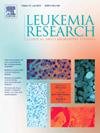白血病表观基因组调控因子ZNF384的鉴定
IF 2.1
4区 医学
Q3 HEMATOLOGY
引用次数: 0
摘要
白血病是一种复杂的血液学癌症,由影响基因表达的遗传和表观遗传变化驱动。了解这些分子机制对于改善白血病的诊断和预后至关重要。本研究探讨锌指蛋白ZNF384在白血病表观基因组中的作用及其对基因调控的影响。我们分析了来自The Encyclopedia of DNA Elements (ENCODE)的下一代测序数据,整合了ZNF384的染色质免疫沉淀测序(ChIP-seq)和调性组蛋白标记、RNA测序(RNA-seq)以及K562和GM12878细胞的Hi-C数据。此外,我们使用了通过CRISPR干扰(CRISPRi)产生的K562 ZNF384敲低(KD)细胞的RNA-seq来验证我们的发现。这使我们能够探索ZNF384的染色质相互作用模式及其调控影响。我们的研究结果表明,ZNF384与K562和GM12878细胞中的启动子和增强子结合,促进转录水平的提高。我们还发现ZNF384在拓扑相关结构域(TAD)边界和染色质环上富集,这表明它在三维染色质组织中起作用。此外,我们在K562和GM12878细胞中发现了ZNF384与SINE-Alu元件的显著结合。综上所述,本研究突出了ZNF384在白血病表观基因组中的调控作用及其对基因表达的影响。了解ZNF384的致癌意义可能会改善白血病的诊断和预后。本文章由计算机程序翻译,如有差异,请以英文原文为准。
Identification of ZNF384 as a regulator of epigenome in leukemia
Leukemia is a complex hematologic cancer driven by genetic and epigenetic changes that impact gene expression. Understanding these molecular mechanisms is essential for improving leukemia diagnosis and prognosis. This study examines the role of the zinc finger protein ZNF384 in the epigenome and its influence on gene regulation in leukemia. We analyzed next-generation sequencing data from The Encyclopedia of DNA Elements (ENCODE), integrating datasets such as chromatin immunoprecipitation sequencing (ChIP-seq) of ZNF384 and regulatory histone marks, RNA sequencing (RNA-seq), and Hi-C data from K562 and GM12878 cells. Additionally, we used RNA-seq from K562 ZNF384 knock-down (KD) cells generated via CRISPR interference (CRISPRi) to validate our findings. This enabled us to explore the chromatin interaction patterns of ZNF384 and its regulatory impact. Our results demonstrate that ZNF384 associates with promoters and enhancers in K562 and GM12878 cells, facilitating increased transcription levels. We also found ZNF384 enriched at topologically associating domain (TAD) boundaries and chromatin loops, suggesting a role in three-dimensional (3D) chromatin organization. Furthermore, we identified a significant binding of ZNF384 at SINE-Alu elements in both K562 and GM12878 cells. In summary, this study highlights the regulatory role of ZNF384 in the leukemia epigenome and its impact on gene expression. Understanding the oncogenic implications of ZNF384 may improve leukemia diagnosis and prognosis.
求助全文
通过发布文献求助,成功后即可免费获取论文全文。
去求助
来源期刊

Leukemia research
医学-血液学
CiteScore
4.00
自引率
3.70%
发文量
259
审稿时长
1 months
期刊介绍:
Leukemia Research an international journal which brings comprehensive and current information to all health care professionals involved in basic and applied clinical research in hematological malignancies. The editors encourage the submission of articles relevant to hematological malignancies. The Journal scope includes reporting studies of cellular and molecular biology, genetics, immunology, epidemiology, clinical evaluation, and therapy of these diseases.
 求助内容:
求助内容: 应助结果提醒方式:
应助结果提醒方式:


